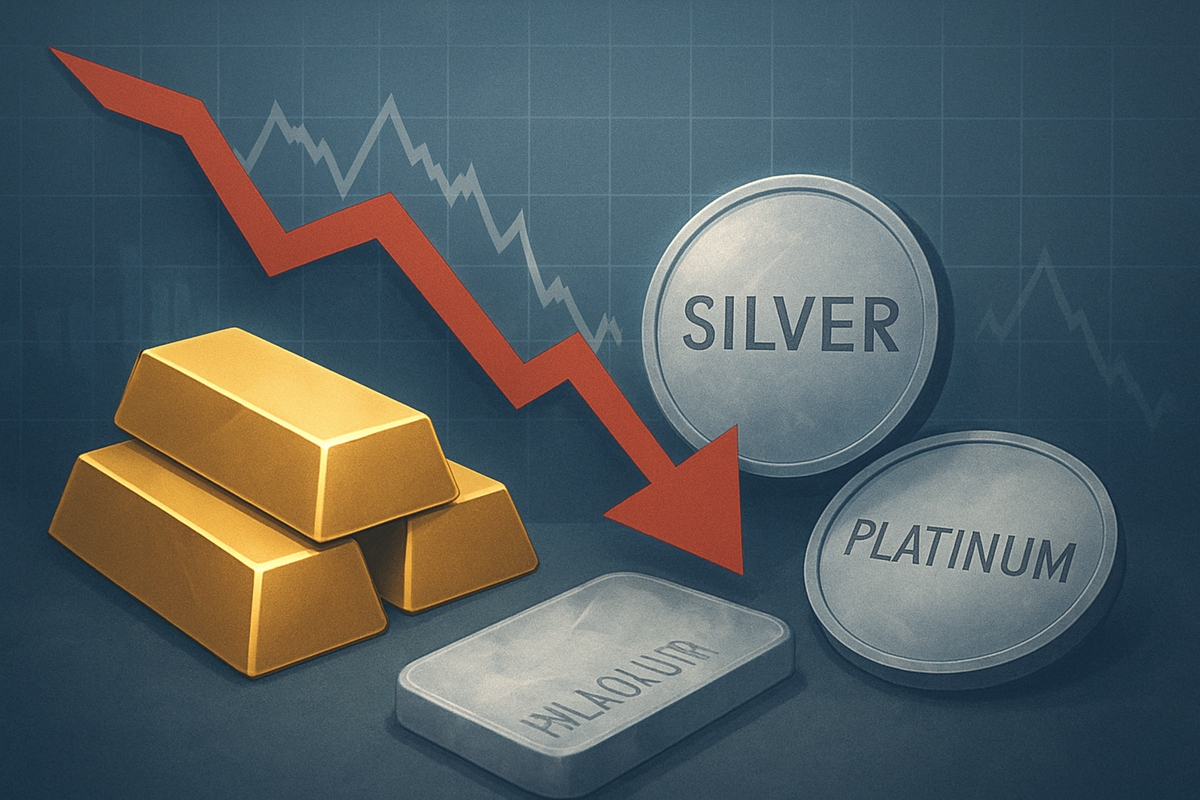
The precious metals market experienced a notable downturn on November 14, 2025, with gold, silver, platinum, and palladium all registering significant price drops. This widespread decline was primarily fueled by a shift in sentiment regarding future interest rate cuts from the U.S. Federal Reserve, as hawkish statements from officials dimmed earlier hopes. Market expert Jim Wyckoff highlighted aggressive profit-taking and a reduction in safe-haven demand as additional powerful forces contributing to the bearish trend across the board.
Detailed Coverage: A Day of Steep Declines Across the Board
November 14, 2025, proved to be a challenging day for investors in precious metals, as a confluence of macroeconomic factors and technical selling pressure drove prices sharply lower. The primary catalyst, as analyzed by Jim Wyckoff, was the Federal Reserve's increasingly hawkish stance, which significantly reduced market expectations for a December interest rate cut. This shift in outlook prompted considerable profit-taking among shorter-term futures traders and triggered widespread long liquidation, exacerbating the downward momentum.
Gold, often seen as a safe-haven asset, bore the brunt of this selling pressure. The New York Spot Price for gold plummeted by $104.50, or 2.51%, to settle at $4,065.80 per ounce, having traded between a high of $4,211.70 and a low of $4,032.20 during the day. Despite a weaker U.S. Dollar Index, which typically offers support to gold, the intensity of the selling overwhelmed any potential positive impact. The reopening of the U.S. government, following a prolonged shutdown, also contributed to a diminished need for safe-haven assets, further pressuring gold prices. December gold futures mirrored this trend, last reported down $75.50 at $4,119.00 in early U.S. trading.
Silver followed a similar trajectory, experiencing a substantial drop of $1.68, or 3.21%, to reach a New York Spot Price of $50.53 per ounce. Its daily trading range spanned from $50.02 to $53.60. Wyckoff's analysis for silver largely aligned with gold, attributing its sharp downturn to the same combination of reduced Federal Reserve rate cut expectations and aggressive profit-taking by futures traders. December silver prices were down $1.53 at $51.63, reflecting the broad market sentiment.
Platinum prices also moved notably lower, with the New York Spot Price falling by $37.00, or 2.34%, to $1,544.00 per ounce. The metal traded within a range of $1,519.00 to $1,618.00. This decline continued a trend observed on the previous day, underscoring persistent selling pressure. Palladium, however, recorded the largest percentage drop among the precious metals, plunging by $42.00, or 2.98%, to a New York Spot Price of $1,368.00 per ounce. Its daily range was from $1,354.00 to $1,473.00. Palladium's retreat on November 14, 2025, marked a continuation of a downward trend from its mid-October peak of $1,655, further impacted by softening rate cut expectations and eased safe-haven demand following a U.S.-China trade agreement. While the Fed recently delivered a 25-basis-point rate cut, Chair Jerome Powell's cautious remarks against guaranteed further easing contributed significantly to the overall bearish sentiment across the industrial and monetary metals.
Corporate Fortunes Tied to Metal's Descent: Miners, Refiners, and Streamers Brace for Impact
The sharp downturn in precious metals prices on November 14, 2025, sent immediate ripples through the publicly traded companies operating within the sector. Miners, refiners, streaming and royalty companies, and even specialized traders are all facing the implications of a market that has suddenly turned bearish. For major gold producers like Newmont (NYSE: NEM), Barrick Gold (NYSE: ABX), and Agnico Eagle Mines (NYSE: AEM), a 2.5% decline in gold prices directly translates to reduced revenue per ounce sold, compressing already tight profit margins. Similarly, leading silver miners such as Pan American Silver Corp. (NASDAQ: PAAS) and First Majestic Silver Corp. (NYSE: AG) would see their top lines diminish in the wake of silver's more than 3% drop.
The impact extends beyond just the daily revenue. Stock prices of these mining companies are highly correlated with the underlying commodity prices, often exhibiting a leveraged response. A 2-3% fall in metal prices can frequently lead to a disproportionately larger percentage decline in their equity valuations, as investors adjust their expectations for future earnings and project viability. This was likely evident in early trading following the price drops. For platinum group metals (PGM) producers like Sibanye-Stillwater (NYSE: SBSW) and Impala Platinum Holdings (OTCQX: IMPUF), the significant declines in platinum and palladium prices pose similar challenges, potentially forcing a re-evaluation of operational costs and capital expenditure plans.
Precious metals streaming and royalty companies, including Wheaton Precious Metals Corp. (NYSE: WPM) and Franco-Nevada Corporation (NYSE: FNV), while benefiting from fixed-cost purchase agreements, are not entirely immune. Their stock prices often reflect broader sector sentiment, and a sustained downtrend in metal prices can narrow the spread between their acquisition costs and market selling prices, impacting their profitability and perceived future value. Refiners like those under Heraeus Precious Metals or Umicore SA (EBR: UMI) might experience less direct immediate stock price volatility but face risks related to inventory revaluation and potentially reduced processing volumes if miners delay sales in anticipation of a price rebound. In the longer term, a bearish market can lead to reduced exploration budgets, delayed project developments, and increased pressure for cost efficiencies across the entire precious metals supply chain, potentially paving the way for industry consolidation.
Wider Significance: A Shift in Monetary Policy Narrative and Global Market Dynamics
The sharp decline in precious metals on November 14, 2025, carries wider implications, signaling a significant shift in the prevailing monetary policy narrative and its ripple effects across global financial markets. The Federal Reserve's hawkish statements, effectively dampening expectations for further interest rate cuts, suggest a central bank more concerned with inflation control or maintaining financial stability than stimulating economic growth through looser monetary conditions. This stance has historically been a headwind for non-yielding assets like gold and silver, as higher interest rates increase the opportunity cost of holding them.
This event fits into a broader trend where central bank guidance plays a pivotal role in commodity markets. When the market perceives a clear path towards tighter monetary policy or a pause in easing, assets traditionally seen as inflation hedges or safe havens tend to lose their luster. The U.S. dollar, though slightly weaker on the day, could find renewed strength if the Fed's hawkish tone persists, further pressuring dollar-denominated commodities. Moreover, the easing of safe-haven demand, partly attributed to the U.S.-China trade agreement, suggests a degree of geopolitical stability that reduces the appeal of traditional crisis hedges. This could have ripple effects on other asset classes, potentially encouraging capital flows into riskier assets like equities, assuming the economic outlook remains robust despite the lack of further rate cuts.
Historically, periods of sustained hawkish Federal Reserve policy have often coincided with challenging environments for precious metals. Comparing this to similar periods, such as the tightening cycles of the late 1970s or early 2000s, reveals a pattern where rising real interest rates diminish the attractiveness of gold and silver as alternative investments. The current scenario, where the Fed delivered a rate cut but cautioned against future easing, creates uncertainty, leading to volatile market reactions as investors recalibrate their strategies. This highlights the delicate balance central banks must maintain between supporting economic growth and managing inflation, with every nuanced statement having profound impacts on asset valuations globally.
What Comes Next: Navigating a Less Accommodative Monetary Landscape
Looking ahead, the precious metals market faces a period of re-evaluation and potential volatility. In the short term, investors will be closely monitoring upcoming Federal Reserve communications for any further clarification on their monetary policy trajectory. Should the hawkish sentiment persist or strengthen, it could lead to continued downward pressure on gold, silver, platinum, and palladium prices, as the market fully prices in a less accommodative interest rate environment. Technical indicators, which have been breached during this sharp decline, may also signal further bearish momentum in the immediate future, prompting more speculative selling.
In the long term, the outlook for precious metals will hinge on several interconnected factors. A sustained period of higher real interest rates could diminish the investment appeal of these metals, pushing investors towards yield-bearing assets. However, any resurgence of geopolitical tensions, unexpected inflationary pressures, or a significant economic slowdown could quickly re-ignite safe-haven demand, providing a floor for prices. Strategic pivots for mining companies might include intensifying cost-cutting measures, optimizing operational efficiencies, and carefully reviewing capital allocation for new projects. Streaming and royalty companies might find opportunities to acquire new streams from distressed miners, while refiners will need to manage inventory risk diligently.
Market opportunities could emerge for contrarian investors looking for entry points if prices stabilize at lower levels, particularly for industrial metals like platinum and palladium, whose demand is tied to economic growth. Conversely, challenges will include navigating potential further capital outflows from precious metals-focused funds and adapting to a market where the "Fed put" (the belief that the Fed will intervene to support markets) might be perceived as less potent. Potential scenarios range from a continued grinding bear market if the global economy remains stable and the Fed stays firm, to a sharp rebound if unforeseen crises or inflationary spikes emerge.
Comprehensive Wrap-Up: A New Chapter for Precious Metals
November 14, 2025, marks a pivotal moment for the precious metals market, characterized by a decisive shift towards a bearish sentiment driven by a less dovish Federal Reserve. The widespread declines across gold, silver, platinum, and palladium underscore the powerful influence of monetary policy expectations on these assets. Key takeaways include the significant impact of diminished rate cut hopes, aggressive profit-taking, and reduced safe-haven demand. Gold's 2.51% drop, silver's 3.21% plunge, platinum's 2.34% decrease, and palladium's 2.98% fall highlight the synchronized nature of this market correction.
Moving forward, the market will likely be dominated by the ongoing narrative surrounding interest rates and global economic stability. Investors should assess their portfolios for exposure to precious metals and related equities, understanding that the landscape for non-yielding assets has become more challenging in a potentially higher real interest rate environment. The immediate future may see continued volatility, and market participants will be scrutinizing every piece of economic data and central bank commentary.
What investors should watch for in the coming months includes any changes in the Federal Reserve's rhetoric, inflation data that could alter monetary policy expectations, and geopolitical developments that might rekindle safe-haven demand. The resilience of industrial demand for platinum and palladium, particularly from the automotive and green energy sectors, will also be a crucial factor. Ultimately, this event signals a new chapter for precious metals, where their role as a hedge against inflation and uncertainty will be continually tested against the backdrop of evolving global economic and monetary conditions.
This content is intended for informational purposes only and is not financial advice





